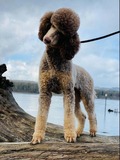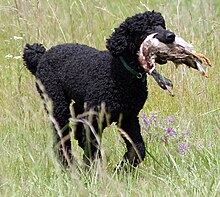Breed History
While we all know the poodle we currently have and love, some may ask where they came from farther back then just the breeder. For this we have sited some history on the breed for those that love to read.
A majority of cynologists believe the Poodle originated in Germany, and the dog they refer to is roughly equivalent to the modern Standard Poodle variety. It is claimed it was known in Germany from the Middle Ages, and it was Germany's water dog, just as England had the English Water Spaniel, France the Barbet, Ireland the Irish Water Spaniel and the Netherlands the Wetterhoun.[1][2][3][4][5] Among the evidence used to support this theory is the indisputably Germanic name for the breed, Poodle or "Pudel" in German, which is derived from the Low German word "puddeln", which means "to splash". Additionally, there exists a number of artistic works, by various German artists, and from as early as the 17th century, that depict dogs of recognisably Poodle type.[1][2][3][5] Some cynologists believe the Poodle originated in France, where it is known as the "Caniche" (French for "duck dog"), and that the breed descends from the Barbet. This view is shared by the Fédération Cynologique Internationale (FCI).[6][7] Others argue that the breed originated in Russia, Piedmont or Northwest Africa.[4][7]
Whatever the Poodle's country of origin, both their German and French breed names indicate the modern Poodle's ancestors were widely used by waterfowlers both to retrieve shot game and to recover lost arrows and bolts that had missed their mark.[3][4] The breed's distinctive lion coat clip developed as a practicality when they were used as waterfowler's dogs, with the long hair around the chest providing insulation for the dog's vitals in freezing water, while the shorn hindquarters reduced drag whilst swimming and the tufts of hair on the legs provided purchase in the water.[3][5]
Size variants
 |
|||||||||||||||||
| Other names | |||||||||||||||||
|---|---|---|---|---|---|---|---|---|---|---|---|---|---|---|---|---|---|
| Origin | Germany or France (see history) | ||||||||||||||||
|
|||||||||||||||||
|
|||||||||||||||||
Due to their intelligence, obedient natures, athleticism and looks the Poodle was frequently employed in circuses, particularly in France.[2][3][5][7] It was in French circuses that the breed was selectively bred down in size to create what is now known as the Miniature Poodle, which was until 1907 known as the Toy Poodle, as a smaller sized dog is easier to handle and transport in a travelling circus.[5] As circus performers the variety was frequently seen performing all manner of tricks including walking tightropes, acting out comedies and even performing magic and card tricks. Outside of the circus the variety was to become an extremely popular companion dog.[2][3][5]
The Poodle, a 1700s painting of the traditional Poodle
The Toy Poodle was created at the beginning of the 20th century when breeders again bred the Miniature Poodle down in size to create a popular companion dog.[2][3][5] Initially, these efforts were not entirely effective, and disfigured or misshapen pups, as well as pups with behavioural problems, were seen frequently, as a result of irresponsible breeding for dwarfed size only. As time progressed, and new breeding practices were adopted, the variety became set as a toy sized replica of the original.[2][3][5] Later attempts to create an even smaller variety, the Teacup Poodle, were unable to overcome serious genetic abnormalities and were abandoned.[5]
The last of the Poodle varieties to be recognised was the Medium Poodle, which in size is mid way in between the Standard and the Miniature Poodle. Not universally recognised by the world's kennel clubs as a variety, the Medium Poodle is recognised by the FCI and most Continental European kennel clubs.[3][5][6] One of the reasons for creating this fourth size variety is believed to be a desire to reduce the number of entries of Poodles by variety at conformation shows.[5]
Recent history
The Poodle was recognised by the Kennel Club of the United Kingdom in 1874, and by the American Kennel Club (AKC) in 1886, soon after the founding of both clubs.[8] In the United States, poodles were quite unpopular until 1935, when the Poodle Champion Nunsoe Duc de la Terrace won best in show at Westminster. Afterwards, they rapidly gained prominence, becoming the most popular breed from 1960 to 1982.[9][10] Since 1935, Poodles have won best in show at Westminster 10 times, the second-most of any breed.[11] As of 2012, the Poodle was the third-most popular FCI registered breed worldwide, after the Labrador Retriever and German Shepherd, with 118,653 new dogs registered per year from the 25 countries surveyed.[12]
Appearance
Silver Beige Phanntom Standard Poodle
The Poodle is an active, athletic breed with the different breed varieties varying predominantly by their size.[1][2][3] The FCI's breed standard states the Standard Poodle stands between 45 and 62 centimetres (18 and 24 in), the Medium Poodle between 35 and 45 centimetres (14 and 18 in), the Miniature Poodle between 28 and 35 centimetres (11 and 14 in) and the Toy Poodle 24 and 28 centimetres (9.4 and 11.0 in). Some kennel clubs do not recognise the Medium Poodle variety. Those typically have the Standard Poodle between 38 and 60 centimetres (15 and 24 in) and Miniature Poodle between 28 and 38 centimetres (11 and 15 in), with the toy variety remaining unchanged.[3][5][6] A healthy adult Standard Poodle typically weighs between 20 and 32 kilograms (44 and 71 lb), a Medium Poodle between 15 and 19 kilograms (33 and 42 lb), a Miniature Poodle between 12 and 14 kilograms (26 and 31 lb) and a Toy Poodle between 6.5 and 7.5 kilograms (14 and 17 lb).[3]
Coat
Poodles are often cited as a hypoallergenic dog breed. Their individual hair follicles have an active growth period that is longer than that of many other breeds of dogs; combined with the tightly curled coat, which slows the loss of dander and dead hair by trapping it in the curls, an individual Poodle may release less dander and hair into the environment. However, researchers have generally not found a difference in allergens across breeds.[13][14][15]
The Poodle does shed, but instead of the fur coming off the dog, it becomes tangled in the surrounding hair. This can lead to matting without proper care. Texture ranges from coarse and woolly to soft and wavy. Poodle show clips require many hours of brushing and care per week, about 10 hours/week for a Standard Poodle. Poodles are usually clipped down into lower-maintenance cuts as soon as their show careers are over. Pet clips are much less elaborate than show and require much less maintenance. A pet owner can anticipate grooming a Poodle every six to eight weeks.
Clips and grooming
Miniature Poodle Poodle in a Modified Continental clip
Over 50 different styles of coat clips are recognised for the Poodle. The most popular in the show ring is the Continental clip, where the face and rear end of the body are clipped, leaving tufts on the hocks and tip of the tail and rosettes on the hips.[5] A similar clip was historically used to prevent the poodle from getting weighted down by their fur when swimming to retrieve a bird, while still leaving their joints and vital organs covered.[11] Pet poodles are most often clipped evenly over their entire body, with the face and paws cut shorter. This is known as the sporting clip.[16]
In most cases, whether a Poodle is in a pet or show clip, the hair is completely brushed out. Poodle hair can also be "corded" with rope-like mats similar to those of a Komondor or human dreadlocks. Though once as common as the curly Poodle, corded Poodles are now rare. Corded coats are difficult to keep clean and take a long time to dry after washing. Any Poodle with a normal coat can be corded when its adult coat is in. Corded Poodles may be shown in all major kennel club shows.[6][16][17]
Colours
A parti-Poodle has patches of any accepted solid colour over a white coat. The coat will usually be white and coloured in equal amounts, though it can vary as long as the coat is at least half white.[20] When a parti-coloured Poodle has markings that resemble those of a tuxedo, it is called a "tuxedo" Poodle. The upper coat is solid black: head, back, tail; and the lower coat is white: neck, chest, abdomen, and legs, making up usually 40% or more of the coat. An abstract Poodle is primarily solid-coloured, with patches of white.[21]
Phantom Poodles have a solid main color with a lighter colour appearing on their "eyebrows", muzzle and throat, legs and feet and below their tail. Like Dobermans, phantom Poodles often have either a black or brown main coat with tan (usually apricot or red) lighter colourings around the eyebrows, muzzle, throat, legs, feet, and below their tail. Phantom Poodles may also have a full face of the secondary color.[20]
Temperament
Poodles are known as a highly intelligent, energetic, and sociable breed. A 1994 study by Stanley Corey ranked them second out of 110 breeds in intelligence.[22] They are an active dog, requiring regular physical and intellectual activities.[23] Shyness or sharpness is considered a serious fault in the breed.[24] Though not suitable as a guard dog because it is neither a territorial breed nor particularly aggressive, Poodles tend to be protective of their families.[23]
Of the size varieties, Standard Poodles are the most highly recommended for families with children. As with all dogs, introductions to babies should be gradual, though most Standards will tolerate a baby and learn to be gentle and will respect toddlers so long as the child is supervised. A Standard Poodle will be fine in a family with many children provided the environment is stable, orderly, and relaxed, with enough room for the dog to go out and retire somewhere quiet if needed.[25] The Miniature and Toy varieties tend to have less patience with young children and might find them too much to handle.
Health
The Poodle Health Registry lists over 50 major health disorders of Standard Poodles.[8] Overall, the Poodle is a comparatively healthy breed, and there are no Poodle-specific health problems. Nevertheless, they suffer from a number of hereditary diseases due to inbreeding. One study estimated that two average Standard Poodles are about as closely related as "the offspring of two full sibling village dogs". Some of the worst common hereditary poodle diseases are sebaceous adenitis (estimated prevalence 2.7%), a skin disease and Addison’s disease, an endocrine system disorder. Both diseases became more prevalent in poodles after the 1960s burst in poodle popularity led to rapid careless breeding aimed at producing good show dogs.[26][8]
Work and sport
Poodle retrieving a duck
Poodles were originally breed for waterfowl hunting.[18] Despite this history, it is currently classified as a companion dog by the FCI.[18] Since the late 1980s, some breeders in the United States and Canada have been selecting for dogs with drive for birds in order to revive the breed for hunting, with some success.[27]
Poodles have been used as working dogs in the military since at least the 17th century, most likely because of their highly intelligent, trainable nature and background as a gundog making them suitable to battlefields, as evidenced by their ability to be trained to ignore gunfire. During the English Civil War, Prince Rupert of the Rhine had a famous hunting Poodle he brought over with him from what is today Germany who would ride into battle with his master on horseback. Napoleon Bonaparte wrote in his memoirs about the faithfulness of a grenadier's pet Poodle who stayed with the body of his master at the Battle of Marengo.[28]
Poodles are highly trainable dogs that typically excel in obedience training.[23] Historically, they were a popular circus dog. In addition to hunt tests, they do well in agility and rally.[11] They are among the most popular service dog breeds.[29]



